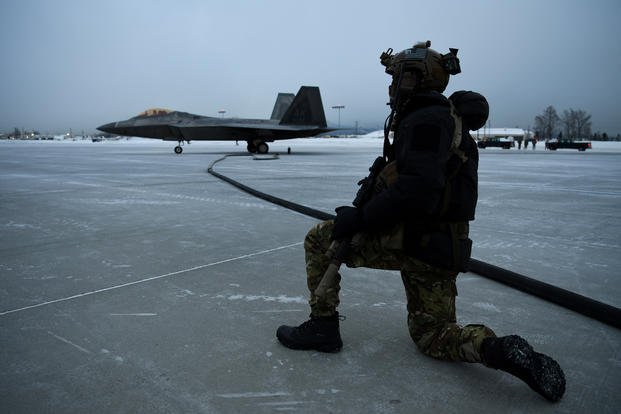Pilots typically never like to see an aircraft's fuel gauge tick down to almost empty -- especially if they are flying one of the most expensive fifth-generation stealth fighters in the world.
Recently, F-22 Raptor pilots from the Pacific Air Forces' 3rd Wing simulated refueling in a remote location -- a necessary ability should they ever need to touch down and fill up before returning to battle. And special tactics airmen made it possible.
The Air Force on Thursday said aircrew members with the 27th Special Operations Wing at Cannon Air Force Base, New Mexico, and a team of special tactics airmen carried out a "forward area refueling point," or FARP, during Exercise Emerald Warrior at Joint Base Elmendorf-Richardson, Alaska, last month.
It marked the first-ever extreme cold weather FARP exercise with next-generation fighters, the service said in a release.
Related: Ready for the Unexpected: Air Force Drilling Troops in Survival, Response Skills
"If an aircraft is behind enemy lines and running low on fuel, a forward area refueling point may be necessary to refuel that aircraft and carry out the mission," the release states. Personnel such as special reconnaissance airmen (formerly known as special operations weather team) are often some of the first to assess, open and control an airfield for aircraft to come in safely despite hostile conditions.
JBER is experiencing its coldest weather since 2017, according to base releases. During the exercise, temperatures dropped as low as -8 degrees Fahrenheit.
"The ability to refuel aircraft at forward airfields and in austere environments is a critical element of agile combat employment (ACE)," said Air Force Col. Robert Davis, commander of the 3rd Wing at JBER.
"Practicing this capability with special tactics operators enhances our interoperability with the special operations community and increases our ability to generate combat power in a contested environment," Davis said in the release. "Special tactics operators are uniquely suited to seize and control airfields, and demonstrating our ability to conduct forward area refueling in challenging arctic conditions takes ACE to new heights."
In August, the service tested how swiftly it could move its premier stealth fighter -- the F-35 Joint Strike Fighter -- to a forward operating location in the Middle East as part of a larger Defense Department effort to improve how the military prepares to deploy at a moment's notice.
In addition to humanitarian assistance operations, the Air Force has been exploring the use of modular basing for this purpose.
For example, the U.S. has already dedicated millions to build up small hubs designed to house a quick-reaction force across Europe. The Air Force has conducted exercises in Eastern Europe in recent months to see how effectively it can build up, tear down and move to get closer to a potential crisis.
At the same time, Air Force Special Operations Command units have been testing how quickly its members can position themselves for the next fight -- either at a remote airfield or beyond tactical boundaries -- all while juggling unexpected circumstances.
During the latest ACE test, the airfield was surveyed and secured while MC-130J Commando II aircraft refueled the Raptors on the ground, according to 1st Lt. Alejandra Fontalvo, a spokeswoman for the 24th Special Operations Wing.
"F-22s and F-35s were designed to compete and win against advanced adversaries," said a special tactics officer, not named in the release.
"Working with the newest and most advanced fighters in the Air Force provides special tactics the opportunity to maintain technological edge and develop the tactics, techniques and procedures needed in order to leverage their full capabilities," the officer said.
-- Oriana Pawlyk can be reached at oriana.pawlyk@military.com. Follow her on Twitter at @Oriana0214.
Read more: SEAL Boss to Depart After 2 Years; Officials Say No Indication He Was Forced Out













